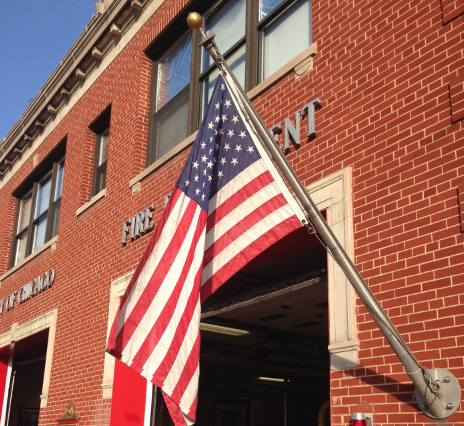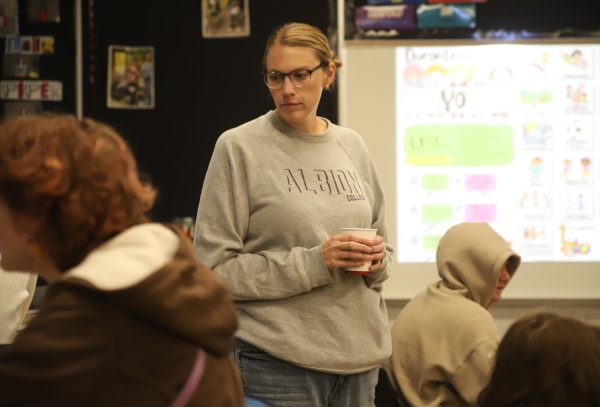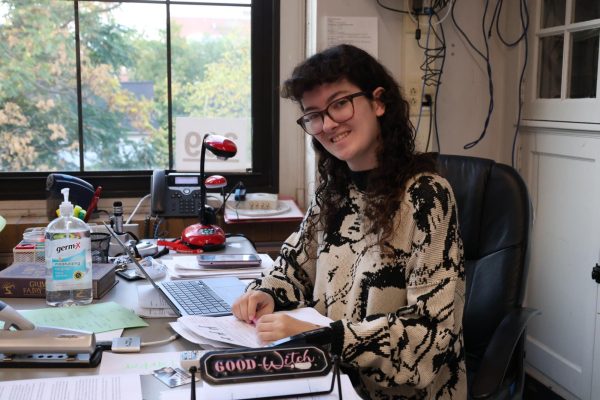Rising Through the Flames
The Chicago Fire Department Through the Eyes of One Lieutenant.

Photo Courtesy: Joe Goblet
Joe Goblet did not plan on becoming a firefighter. He attended St. Louis University after growing up in Southwest Chicago;Goblet graduated with a major in Communications and a minor in Marketing with the intent of becoming an advertiser, but somehow found himself at the Chicago Fire Department (CFD) instead.
Goblet joined the CFD when he got out of college. “It just so happened that I didn’t know what I wanted to do for a career, and they happened to announce a test [to get into the fire academy],” Goblet said. “Because it’s working for a big city, you can only apply and take the test when they give it.”
Flash forward 20 years and Goblet has been promoted twice within the department. Similar to getting into the fire academy, promotions within the fire department are mainly due to timing. “You never quite know when the tests are coming around,” Goblet said. “There’s no schedule, they will just announce when the tests are coming and you just have to prepare regardless.”
Everybody in the CFD starts as a candidate firefighter and spends six months in the fire academy. The following year, candidate firefighters are placed at firehouses around the city, where they go through training and learn how to firefight on the street, as opposed to how they are taught in the academy. During that year, candidate firefighters cannot go to different firehouses because the administration assumes the candidate firefighters do not know anything.
After roughly 18 months, the candidate name is removed and they become official firefighters for the city of Chicago. People can stay a firefighter for their whole career; they do not have to take promotional exams, but the tests do not occur very often so many employees take advantage of those opportunities.
“Since [promotional exams] don’t happen very often, you can’t really let the opportunity go,” Goblet said. After 12 years of being a firefighter, Goblet became an engineer—a person that drives the engines. Fire engines are the vehicles that pump water, while fire trucks are the vehicles with one or more ladders.
“[I got] to drive something that’s 30 to 40 feet long with lights and sirens and people got out of my way; it was a pretty cool thing to do,” Goblet said. “You still have to follow the rules of the road, and you still have to be a safe driver.”
Six years later the CFD gave another promotional exam to become a Lieutenant—the rank between an engineer and a captain who are in charge of a fire company for the time that they work. Goblet was fortunate enough to get the job with 18 years at the CFD.
According to Goblet, the process of getting promoted within the department takes a long time. The exams are the way officers move up the ladder on the job and since the department gives the opportunity for a promotion so rarely,
many officers take them even when they do not feel like it.
“Three years ago I was promoted to Lieutenant,” Goblet said. “We took the test in 2009 and I wasn’t promoted until March of 2014. We didn’t get our grades until the end of 2012, but if you only have an opportunity to move up once a decade you have very limited opportunities. Right now I’m dealing with the Captain’s test. [I already took the written test at the end of January] and I can’t wait until the oral proficiency half is over.”
Goblet served as a Relief Lieutenant for nine years. Relief officers are not assigned to one specific firehouse, but instead fill in when assigned members are on vacation, injured or sick. The Relief position can be filled in any rank, whether it be Engineer, Lieutenant, Captain or Battalion Chief. “They give you a district that you work in, a general region of the city, [and] I just bounced around every day,” Goblet said.
Goblet felt there were many pros of relieving. “You don’t get involved in a lot of the issues that a house has,” Goblet said. “There might be conflicts between members of the firehouse. I was working with different people, and because I was a Reliever I was working with different firefighters.”
But there are a few cons to not having a house. Some of the camaraderie is lost since relieving officers are at a different house every day. “You can go to a really good house with really good people and once your day is over, you’re on the road again and you don’t get to enjoy that camaraderie every day,” Goblet said. “You might go to a house that might be having issues and you just have to get through the day. I would say 95 percent of my work days were fun.”
For Goblet, The hardest part of being a relieving officer was carrying all of his stuff with him everywhere he went. On a work day, officers live at the firehouse for the day. The worst part for Goblet was having to drag all the gear, bedding and other equipment he was issued to a different firehouse every day.
“My car was my locker, and if we had a big working fire usually all the stuff didn’t smell very good,” Goblet said. “My car smelled like a chimney for about 3 weeks [after that]. There’s also the chance of forgetting stuff, and if you had a bad night and you forgot something, then you had to go back for it.”
Recently, Goblet requested a transfer to Engine 35 and got the spot based on seniority. He now serves at a house in Bucktown, roughly 20 minutes away from his home in southwest Chicago.
When people call 911, it goes to an alarm center called the OEMC. From there, it goes to a building with a map of the whole city. They are able to get the address based on the phone number and they send the run based on the emergency.
The OEMC sends the run to the computer systems in the firehouse, where the bell goes off and a mechanical female voice that tell members of that house what kind of run it is and what the address is. But sometimes there can be misinterpretations from the phone call, turning the process into something akin to a game of telephone.
“The run might start as having a dozen tulips and by the time we get there we have a dozen roses,” Goblet said.
Firefighters are frequently interrupted during simple tasks such as eating and sleeping. “It’s part of the routine,” Goblet said. “It’s like people have a camera on our kitchen [and] they know when the food is put down on the table. There’s nothing like aged scrambled eggs on Sunday mornings. They look so good when you’re sitting down and by the time you get back [from the run] it looks like play-dough you’ve left open for a couple days.”
The stability of being a part of the CFD has been incredible for Goblet. “I’ve been very fortunate to be in a recession-proof occupation,” Goblet said. “It doesn’t matter what the economy does. There are always fires; there are always people who need help.”
However, according to Goblet, there are a lot of strange things out there and disrespect to people in uniform. “[It can be] challenging dealing with people but you just have to be professional and get the job done,” Goblet said.
In a small town, where there are two or three firehouses, it is much easier to maintain all the apparatus needed for the job. But in a big city like Chicago, it is much harder to keep the equipment up to date because there are so many firehouses. The CFD employs over 5,100 firefighters, engineers, lieutenants, captains and battalion chiefs, with roughly 100 engines and 60 trucks. Keeping the fleet maintained and somewhat new is challenging and very expensive. On top of just the physical things, like equipment, the CFD also has to train all of the the new candidates.
While the CFD may be Goblet’s everyday life, his occupation seems more glamorous to much of the public; since 2012, the TV show ‘Chicago Fire’ has been airing on NBC. The show follows the lives of the firefighters and paramedics working at the CFD at the firehouse of Engine 51, Truck 81, Squad 3, Ambulance 61 and Battalion 25. Now airing the fifth season, ‘Chicago Fire’ has generated several spin-offs running in the same alternate universe such as ‘Chicago Med’, ‘Chicago P.D.’ and ‘Chicago Justice’.
Goblet frequently gets asked how the show compares with the job and his answer is always the same. “It doesn’t,” Goblet said. “If you take the best runs throughout the course of your career and boil down all the coolest stories that you’ve seen, you can make probably one really cool episode.”
“Chicago Fire” is filmed at an active firehouse. At the firehouse, a large tent is set up behind the house itself where the real rigs run out of when they are filming. The show is filmed at one of the newest firehouses in the city, located slightly Southwest of the Loop. It used to be one of the oldest houses in Chicago, but it was falling into disrepair so a new house was built. The house is located close enough to downtown so the Chicago skyline can be in shots of the show.
“The first year they were filming the TV show, [the chief that advising them was asked] ‘How do we get the stunt men on the roof to look more like firemen?’ and he said ‘Use real firemen because we’re used to it,’” Goblet said. It is an unusual thing to walk on a peaked roof. The producers are always looking for fresh faces to be on the show. They look for different people to be in big trauma scenes where there are multiple victims or need real firefighters to fill in big action shots.
But in the reality of Goblet’s job, every now and then, a run is successful and the overall outcome is good, whether it be finding someone in a house fire or saving someone who has a sudden illness. A successful run to Goblet is when everybody at the firehouse does their job effectively and gets home safely. “I tell people all the time [that] regardless of the stuff we have to face, the most important part of out job is to go home because we all have families,” Goblet said. “It always feels good when we help other people and that’s what we’re there for. But the best feeling is when we get to come home safe.”
Since Goblet has been apart of the CFD, he’s been told by others in the force that the number of fires down. “I think a lot of that is due to prevention and a lot of that is due to the technology in houses now with smoke detectors and CO detectors keeping people safer,” Goblet said.
Fire drills take place throughout the country because of a tragedy in the city of Chicago. On Dec. 1, 1958, a fire broke out in the basement of the ‘Our Lady of the Angels’ school in Humboldt Park. The fire started in the basement near a stairway in the old elementary school. There were approximately 1600 students in the building at the time, with the fire killing 92 children and 3 nuns. Many more were injured as they jumped from the second-floor windows to escape the smoke, fire and toxic gasses that filled the school.
Chicago tragedies have influenced other fire safety techniques such as movie theater doors. The Iroquois Theater fire occurred on Dec. 30, 1903 is considered to be the deadliest theater fire in the history of the United States. The fire killed at least 602 people, starting from an electrical short-circuit. Many people attending the matinee performance who attempted to exit the burning theater got stuck inside because they had inward-swinging doors. The first people to the doors could not open them because the people behind them were smashing them into the doors and everybody was trapped inside. According to Goblet, this is why movie theater doors all open outward when you’re exiting the theater.
Most of the fire service job evolves from tragedies that have happened; most of the training within the fire department originated from trying to avoid tragedies from occurring again. That is where a lot of the rules and regulations come in and the standard operating procedures into the future. “If it wasn’t for tragedies that have happened in the past, you wouldn’t think about how to improve the way of life and how to keep people safer out there,” Goblet said. “It’s pretty cool the number of fires are down. [It’s] a great thing with regards to the general public because it’s keeping everybody safer.”








